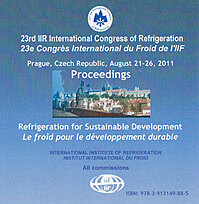
Résumé
A transcritical carbon dioxide (CO2) Rankine power cycle has been analyzed based on first and second law of thermodynamics. Detailed simulations using distributed models for the heat exchangers have been performed in order to develop the performance characteristics in terms of e.g., thermal efficiency, exergetic efficiency and specific net power output. A generic cycle configuration has been used for analysis of a geothermal energy heat source. This model has been validated against similar calculations using industrial waste heat as the energy source. Calculations are done with fixed temperature and mass flow of the heat source. The results show the existence of an optimum high pressure for maximizing performance and for minimizing the heat transfer area. The exergy analysis specifies points of potential improvement in the heat exchanger temperature match and points to optimal operating conditions for the high side pressure. In addition the results underline that the investment cost for additional heat exchange components such as an internal heat exchanger may be unprofitable in the case where the heat source is free.
Documents disponibles
Format PDF
Pages : 8 p.
Disponible
Prix public
20 €
Prix membre*
Gratuit
* meilleur tarif applicable selon le type d'adhésion (voir le détail des avantages des adhésions individuelles et collectives)
Détails
- Titre original : Modeling and analysis of a transcritical Rankine power cycle with a low grade heat source.
- Identifiant de la fiche : 30001584
- Langues : Anglais
- Source : Proceedings of the 23rd IIR International Congress of Refrigeration: Prague, Czech Republic, August 21-26, 2011. Overarching theme: Refrigeration for Sustainable Development.
- Date d'édition : 21/08/2011
Liens
Voir d'autres communications du même compte rendu (569)
Voir le compte rendu de la conférence
-
Sensitivity and design of a transcritical CO2 c...
- Auteurs : NGUYEN C., VEJE C., WILLATZEN M., et al.
- Date : 25/06/2012
- Langues : Anglais
- Source : 10th IIR-Gustav Lorentzen Conference on Natural Working Fluids (GL2012). Proceedings. Delft, The Netherlands, June 25-27, 2012.
- Formats : PDF
Voir la fiche
-
Modeling and simulation of a transcritical CO2 ...
- Auteurs : SIAN R., WANG C. C.
- Date : 16/08/2015
- Langues : Anglais
- Source : Proceedings of the 24th IIR International Congress of Refrigeration: Yokohama, Japan, August 16-22, 2015.
- Formats : PDF
Voir la fiche
-
A comparative cycle and refrigerant simulation ...
- Auteurs : MADER G., PALM B., ELMEGAARD B.
- Date : 25/06/2012
- Langues : Anglais
- Source : 10th IIR-Gustav Lorentzen Conference on Natural Working Fluids (GL2012). Proceedings. Delft, The Netherlands, June 25-27, 2012.
- Formats : PDF
Voir la fiche
-
Research and analysis on influence factors of a...
- Auteurs : LINGYAN Y., JINTANG L., YIJUN F., NING M., WEI W., MENGMENG B.
- Date : 31/08/2021
- Langues : Anglais
- Source : 13th IEA Heat Pump Conference 2021: Heat Pumps – Mission for the Green World. Conference proceedings [full papers]
- Formats : PDF
Voir la fiche
-
Improvement of the performance of a transcritic...
- Auteurs : GARCIA CASCALES J. R., OTON MARTINEZ R. A., ILLÁN GÓMEZ F., SÁNCHEZ-VELASCO F. J., SENA CUEVAS V.
- Date : 11/11/2020
- Langues : Anglais
- Source : X Congreso Ibérico y VIII Congreso Iberoamericano de Ciencias y Técnicas del Frío, CYTEF 2020.
- Formats : PDF
Voir la fiche
